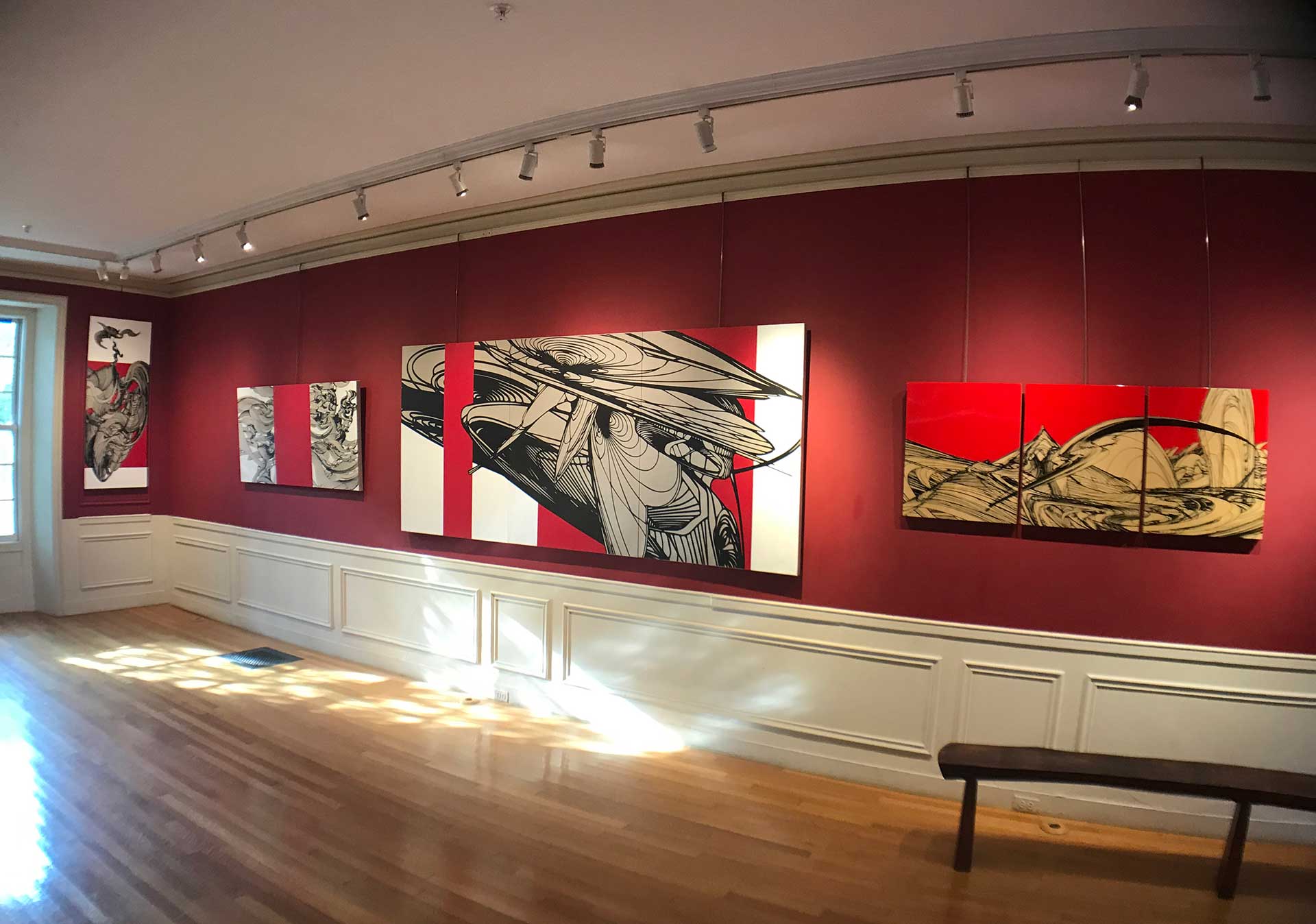 Manchester, VT [map] | (802) 362-1405
Manchester, VT [map] | (802) 362-1405
Opening Reception:
August 31, 2019 2-4 pm
Exhibition Dates:
August 31 – October 6, 2019
Gallery Hours:
Tue-Sat: 10am–5pm & Sun: 12–5pm

Shinzō, 2019.
About the Artist
Long Island-based artist Colin Goldberg’s artwork explores the intersection of painting and digital media. His technology-fueled paintings have been featured in WIRED, The New York Times and PBS. He is a recipient of grants from the Pollock-Krasner Foundation and the New York State Council on the Arts. Goldberg’s paintings reside in the permanent public collections of the Stony Brook University Hospital in Stony Brook, New York, the Pollock-Krasner House and Study Center in East Hampton NY and The Islip Art Museum in Islip, New York.
Artist Statement
“This exhibition is dedicated to the memory of my two grandmothers: Kimiye Ebisu, who taught me the value of perseverance, and Gussie Goldberg, who taught me the value of chutzpah. This work is informed in part by my Japanese-American ancestry, inspired by woodcut artists such as Hokusai and Hiroshige.
This painting, which is one of the works included in my solo exhibition at SVAC, is titled Shinzō, which means “heart” in Japanese. I gave the piece this title because the abstract form reminded me of a human heart when the original composition was completed earlier this year.
I was unaware that two months later, I would be told that I needed open heart surgery. I had the procedure, a mitral valve repair and double bypass, on June 25, 2019 at Stony Brook University Hospital on Long Island. Ironically, the same hospital had purchased five of my paintings for their permanent collection last December. It’s funny how life works, and how art can sometimes function as an oracle into our lives.
Upon getting this news, it became a goal of mine to continue with this exhibition at SVAC despite the surgery, and I used the downtime spent recovering from my procedure to create new work: the companion piece to Shinzō, entitled Hoshū, pictured below (which means “mending”), as well as two grids of small paintings, pictured in progress at the bottom on this page.
All of the works in this exhibition are singular pieces which are computer-assisted – they were drawn digitally, and painted by hand. They are from a body of work which I call my Biomorphic series, and exert a more figurative impulse than much of my other recent work. Their linework is inspired in part by Japanese woodcut artists such as Hokusai and Hiroshige. The compositions suggest forms and scenes which are at once mechanistic and organic. All of the works within this exhibition explore multiple dualities: the gesture and control, the past and the future, abstraction and figuration.

Colin Goldberg: East/West – Solo Exhibition at Southern Vermont Arts Center. Installation View.
When asked about the role that technology plays in my work, I would say that I see the computer both as an extension of myself and as a partner. It is a tool to be used like a brush or a pen. However, I think the computer differs greatly from other tools that humans have developed in the past, as it is truly a tool for the mind. The machine opens up new approaches not only in terms of execution, but within the areas of ideation and conceptualization as well.
For everyday purposes, I use the machine and its software as a tool. When I make art, it is more of a playful interaction. The challenge is knowing when to stop playing. Playing with software can often result in very unexpected results – it’s much like engaging in the Surrealist game The Exquisite Corpse, except it is with a machine instead of with human participants – you never really know what results will emerge.
Drawing digitally, for me, taps into the subconscious impulse in a similar way that the Surrealists used wordplay and automatic drawing. Consciousness only gets involved when the decision is made to hit the “save” button. When people ask me if my work is computer-generated, I usually reply that I consider it computer-assisted.
Instead of beginning with a sketch that is developed into a finished painting, a more intuitive and expressionistic working approach has taken root in my process in past years, where the process of composition would happen organically on a more subconscious level. The conscious component would come afterward, in the titling of the work upon consideration of the results.
Working within this modality for the past fifteen years, the pendulum has started to swing back toward figuration, and the results have begun to resemble “things” again. If I can easily identify a form I have created as something real, I usually feel that I have overworked it, yet if it is formally balanced without the implication or suggestion of something more, then it is still in the category of a design or pattern, and needs further work to qualify for me as art. In my opinion, whether a picture is labeled as figurative or abstract, it is successful when it remains mysterious.

Hoshū, 2019.

Biomorphic Studies in progress in the studio.
COLIN GOLDBERG: EAST/WEST – INSTALLATION IMAGES
ABOUT THE ARTIST: SELECTED PRESS
“If Picasso Had A Macbook Pro”
ARTIST COLIN GOLDBERG’S NEW MOVEMENT MARRIES COMPUTERS AND CRAFT
“Goldberg manages to give technology a seat at his studio table without compromising the human side of creativity.”
– Kendra Vaculin, WIRED

PechaKucha Night Hamptons Vol. 27
Date: 3/15/2019

